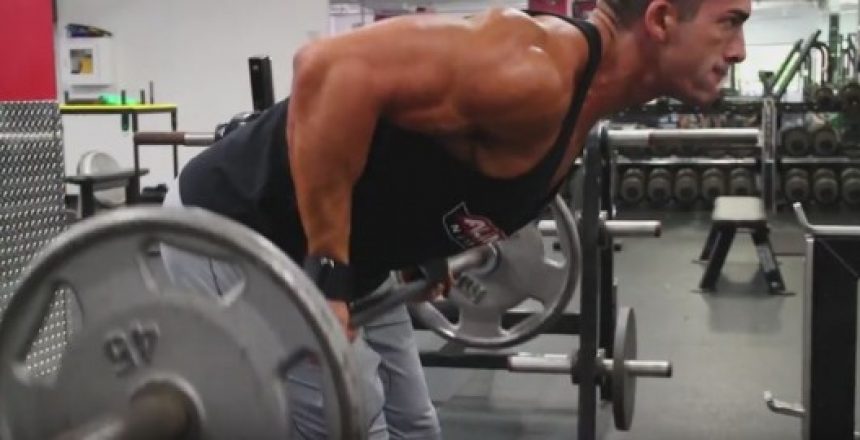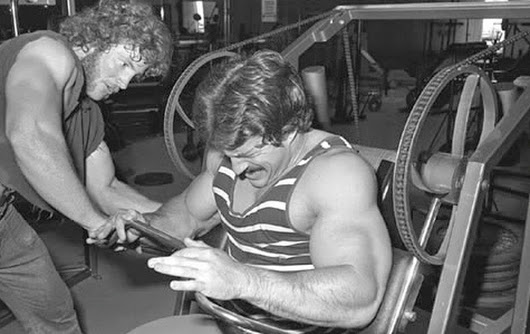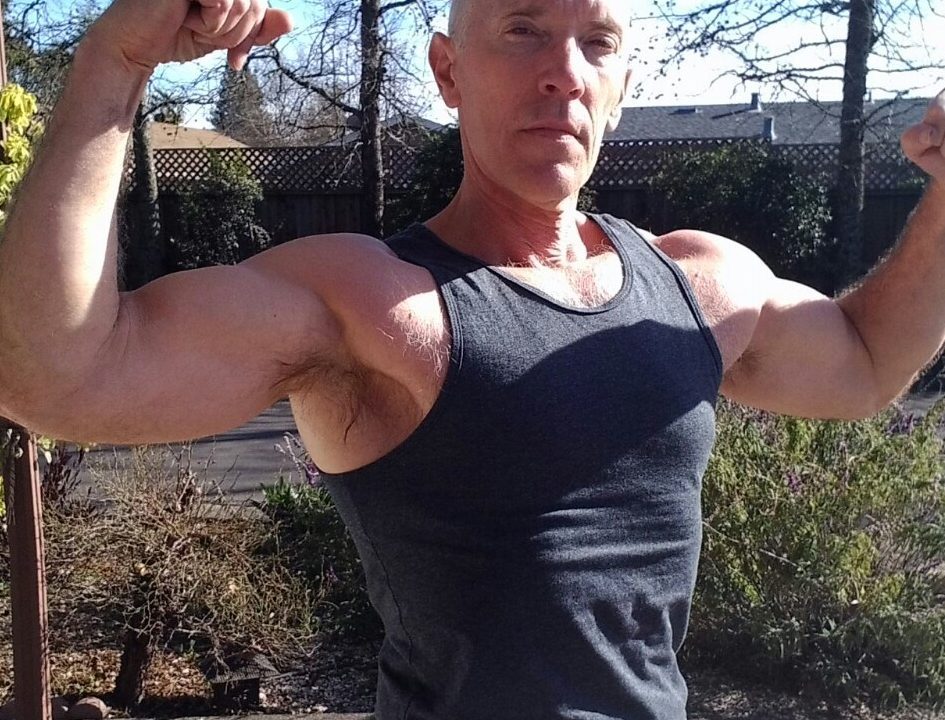I see people in the gym making all kinds of mistakes. I’m not talking about the use of advanced techniques, or taking too much time between sets. Or even too much time spent doing cardio — which is a mistake.
The mistake is with those who want to lift weights but either don’t know how or don’t want to exert enough effort.
They don’t do compound lifts.
What is a compound lift?
When you lift a weight, or push or pull on a resistance training machine (such as a Nautilus), limbs or torso move around the joints.
A compound lift is simply one that moves around two or more sets of joints. They are multi-joint exercises.
Isolation lifts, in contrast, are single-joint exercises.
For example, a row, a move in which you pull a weight (whether a barbell or on a machine) toward you, involves the shoulder joints and the elbows. It’s a compound exercise.
An example of an isolation or single-joint exercise is biceps curls, which is done properly, involves only the elbow joints.
The wrong idea about weight training
Many people seem to have the wrong idea about weight training.
Whether you are in the gym for overall conditioning, for building muscle to prevent aging, or to become an actual bodybuilder, the process should involve working all of the skeletal muscles.
It appears to me — and this is a guess — that many people look at muscular men and see big arms to the exclusion of anything else. They then proceed to do isolation exercises, like biceps curls and triceps pull downs, to the exclusion of most other things.
If your goal is health, work on all of your muscles.
If your goal is size and strength, work on all of your muscles.
Isolation exercises are ineffective
Can you build muscle through isolation exercises?
Yes, you can, but it remains to be seen whether they’re optimal or necessary.
A recent study took a look at the effect of adding isolation, or single-joint, exercise to compound, or multi-joint, exercises, on muscle size and strength in untrained men.1
One group did bench press and lat pulldown, and the second group did those exercises and also did biceps curls and triceps pulldowns. After 10 weeks, the size and strength of the biceps muscles were measured.
No difference was seen between the two groups.
Compound lifts are essential
The basic compound exercises consist of the following:
- bench or chest press
- row
- overhead press
- pull-ups or pull-downs
- leg press or squats
- deadlifts
A program that consists of these moves, and/or variations of them, will give you all the muscle growth you need. (I also contend that the average person who lifts weights doesn’t need to do the last on the list, deadlifts. They cannot be done on a machine and require a barbell as well as training and skill to avoid injury. I do them, but I’m experienced.)
Isolation exercises
Isolation exercises are neither necessary nor sufficient. I must admit that I do them, but I may need to reevaluate. They consist of exercises like the following (not a complete list):
- biceps curl
- triceps pull-down
- leg extension
- calf raise
The study above used untrained men, i.e. newbies to weight lifting. It’s possible that well-trained men may need to use some isolation moves, along with the compound moves, to get the growth that they want.
Conclusion
Isolation exercises may be ineffective in untrained men. Compound exercises suffice for building muscle.
Whether or not you do any isolation exercises, you must do compound exercises for a true, health-promoting weight workout.
PS: Read why strength training is essential and how to do it in my book, Muscle Up.
PPS: Check out my Supplements Buying Guide for Men.
- Gentil, Paulo, et al. “Effect of adding single-joint exercises to a multi-joint exercise resistance-training program on strength and hypertrophy in untrained subjects.” Applied Physiology, Nutrition, and Metabolism 38.3 (2013): 341-344. ↩














22 Comments
Knee problems have stopped me from doing dead-lifts and squats, so I’ve developed the best set of compound exercises I can:
– muscle ups (pull up into a dip)
– reverse hypers (to hit the posterior chain and rehab/prevent back problems)
– GHD, another posterior chain exercise which additionally engages the entire core (front and back)
– overhead presses or handstand dips
Kind of the “knee challenged” version of the big 3 or big 4.
If anyone else has other suggestions, I’d love to know.
Thx.
A.
One suggestion might be leg extensions – it’s an isolation exercise, but works the quads and may not be hard on knees. I like that you’re doing dips, that’s an excellent compound move.
Leg extensions are terrible for your knees…
HA!—I was just about to ask if doing dips are a compound exercise. I’ve found my that pecs have filled out better doing them than when I was benching like crazy.
I get that deep stretch and really activate as much of the fibers as I can. They’re brutal, but I love ’em too much!
Could you please explain what reverse hypers and GHD are?
Reverse Hyperextension: https://youtu.be/i9tU7_w7rvw
GHD: https://youtu.be/koUx97SXj2k
Looks like good advice to me. The only thing I’d add is that the one isolation exercise that may have some value is the calf raise because it’s pretty hard to work the calf muscle in most compound exercises. I sometimes hit the calf raise machine while I’m resting between sets on an upper-body exercise.
A few more that some people may want to consider:
– Power cleans (or snatches) or box jumps
– Sprints
– Front squats (which for most people are a radically different exercise than back squats)
– Sled pushing/pulling
– High-Box step-ups (i have found the strength these build in the lower range of the movement to be very therapuetic for my knees, as with fronts squats as well.)
– Body-weight exercises like bridging
– One-legged leg-presses (Normal leg presses seem to hurt my back due to the roll-up at the bottom of the motion, however doing them one-legged solves this problem (h/t Stu McGill))
After about 8 years of doing the first 5 exercises on your “Compound lifts” list, I added machines that isolate the biceps and triceps, and my arms got notably bigger within a few months. (I didn’t stop doing the rows/chest press/pull-downs/overhead; I just added the other exercises as well.) My triceps weight more than doubled in the first two months on the isolated triceps machine. I speak only for myself, but it’s clear that the compound exercises were not maxing out the potential of my arms for growth.
Recent studies have shown that the most effective way to build muscle/strength is doing repetitions “to failure”. If multiple muscles are involved in a movement (as is the case with compound movements), then the weakest muscle will determine the failure point for the whole group. The remaining muscles would not have reached their point of failure. To me, this is the strongest argument for doing isolated movements. Have not heard anything to counter it yet. Thoughts?
Could you please tell me the links to the studies you read regarding going to failure? I am a big proponent of going to failure, and the more evidence I have the better. Thank you in advance.
Didn’t save the links and references but it’s all over internet/twitter. A simple search would do.
Mentzer preached that doctrine, and has you doing, e.g. leg extension before leg press, on that principle. The problem is that there’s little evidence that it works. I do it myself. Another one is triceps extension, then dips. It seems to me to be of theoretical importance only; hard to see it making that much of a difference. But I could be wrong.
@HF1,
I agree that training through a full range of motion is beneficial and that is where chains and bands are a huge help for squats and presses, and to a lesser extent power rack work. So, you are doing compound movements but with a varying resistance based on the mechanical advantage you have at different points in the lift. The best of both worlds.
However, in my experience there are several problems with the principle you state as it applies to isolation exercises:
– Even if going to failure is the “best” way to train (which I don’t believe it is in the real world where small but consistent improvement over many years with minimal setbacks is key ) that doesn’t mean that a lesser load is not almost as beneficial. If it wasn’t, then gymnasts, olympic lifters, farmers, construction workers, etc. would not be strong.
– As studies have shown, many studies are wrong and I believe that is the case with the ones you reference. The studies that claim to show an advantage for training to failure suffer from at least one major and one minor flaw. The major flaw is that they are usually around 6-12 weeks long, and the minor flaw is that they often use test subjects who are in their first 5 years or so of consistent hard training, when just about anything will appear to “work ” for a while. Of my 37 years of lifting, I spent about 25 of those working up to one set to failure for each exercise, and while I was stronger than the average person (which is not saying much) I never exceeded what I could do when I was starting out and training heavy day/light day. Since about 2010, I have done no sets of any kind to absolute failure and I am now much stronger in my pressing and pulling movements than I ever was before at any time, and my squat, deadlift, and cleans have made decent progress as well. The problem with the studies is that, yes training to failure will produce what appear to be great gains for a period of 4-12 weeks or so, however at least in my case and in a number of other people I know, those gains were followed by burn-out or injury. The study protocols end up looking like those used for peaking for a competition, not something used to build an increasing foundation of strength over the long term.
– In my experience, the real key to long-term gains once the easy beginner gains have been achieved is gaining every year and every decade without significant set-backs, which is where gymnastic-style training with frequent moderate volume, at near but not maximum weights is used. A good example is Dan John’s Easy Strength program, but there are many others. Gymnasts and olympic lifters build tremendous strength repeating the skills of their sport at challenging, but not maximal efforts. When I stopped going to failure and upped the volume of sub-maximal weights I used, I didn’t get the sudden bursts of strength improvement, but the set-backs and injuries went away and my gains became conistent and sustainable to where I far surpassed what I was doing before. I was able to focus on my form much more as well
– Volume with significant weight that doesn’t overly cut your recovery ability is what I have found to work best over long periods of time, and as Layne Norton has discussed in his videos I believe, there is also science that shows volume to be a major factor. For example I do pressing movements above 95% of what would be failure 4 days per weeks with light speed work on another day. If I went to failure on even one set, I know from experience that it would take me 4 days to recover, so the volume I handle now is astronomical compared to what it was when I was going to failure, but with almost no risk of injury or burnout.
– The problem with using just isolation movements, whether to failure or not, is that it just doesn’t work for building overall athleticism and functional strength. Years ago I had a major shoulder injury and could only train most body parts using isolation movements for several months. I’m sure the isolation movements helped, but even so I was very out of shape for the compound movements when my shoulder finally healed. I have never heard of any athlete of any kind who claimed to have built their strength and ability using predominantly isolation movements. Even if you could build the muscle, you wouldn’t have the nervous system development.
Drifter, going “to failure” doesn’t mean using maximal weights. You could use lighter weights and many repetitions (all the way up to 25, I think) as long as the last one is the one where the weights just drop as the muscles can’t hold them and can’t do one more. So, to avoid injury, it is recommended that lighter weights and more repetitions are used at least for relative beginners. I switched from doing 3 or 4 sets to just 2 “to failure” with good results and am considering trying just a single set to failure. But my goal is not maximal strength or muscle mass — just nicely ripped body.
The theory behind this also makes sense to me. By going to failure you’re sending a signal to your body/metabolism that it just failed at whatever you asked it to do (so the lion almost caught you or you almost fell off the cliff) and it better build more muscle/strength for the next time you ask it to do the same thing.
Since learning of the slow, intensive routine here this summer (Praise Be Unto Mangan), I’ve been doing 2 slow sets to failure (or as near as I can come, I have to work on my focus), aiming for 12 x 8-second reps each. I still don’t feel like 1 set is enough, but then again, maybe if I were REALLY getting to absolute failure, it would.
It does wipe me out for more than a day afterwards; there’s no way I could do hard, manual labor on the day after a session. I can still feel my increased heart activity (beating harder, if not faster) now as I write this, 24 hours after a great upper body workout.
I guess I could just simply try a couple of sessions in a row where I really do just one set and see how I feel afterwards.
Heh-heh…Pumping Iron happened to run on TV here the other night, and I watched it. I’d never seen it in its entirety before, just bits and pieces. Goodness, but was Arnie huge! And young Louie…yikes! Their routines in the gym…all the fast reps…
On isolation exercises. Recently, I’ve started doing over-hand curls, over- and under-hand wrist curls, as well as just holding dumbbells at my sides for a minute, to work my skinny, long forearms. They’re growing, bless them.
I also got Fat Gripz after reading about them, and use them on the forearm work as well as on crossover cable curls. Love ’em. Highly recommended.
In my previous weight-lifting life, in my 20’s, nearly 30 years ago, my partner & I surmised that I was a hard gainer. My work and results these days does nothing to contradict this, unfortunately. I’m gaining, but not enough where people who having seen me in months say anything about how I’ve grown. Ah, well.
I try to follow the 80/20 rule. 80% of your results will come from 20% of your exercises. Bench press, squats and deadlifts are my 20%.
It does seem to me that curls done properly are compound exercises, as they will work your forearms as well as the biceps. At least, when I really focus on them, they do. And doing them s-l-o-w-l-y sure gets me well worked up by the end of a set.
As we know, the bicep is an elbow flexor and the the muscles of the forearm(Palm Side) are also flexors. If you were too curl your wrist when flexing, your’e eliminating valuable tension for the biceps to grow. I have noticed when I have my wrist extended when curling, the tension and the “pump” on the biceps is significantly greater, because you aren’t contributing more flexors to the equation. I would recommend extending your wrist, “Waiter’s hold” to elicit more bicep activation.
Could I please ask you a question regarding what I’ve read in your books and various articles. Thanks to your highly informative information I was discussing with some ladies at our gym on why compound exercises are so vital and what they can do for your general training program. They all do Les Mills group class sessions such as Body Pump and Body Attack, which has I’m sure you are well aware of. But they are adamant that these classes give them all the weight training they need. They don’t agree with me re strength training using machines or free weights. My question is do these sorts of group class sessions do anything other than some cardio benefit and some basic muscle toning? There must be some health benefit in them, but what exactly is it? Are your muscles in fact getting any long term benefit in a 45-60 minute group class? Afterall in such classes all would be using fairly light weights in your jumping around activities.
First I’d heard of this. I watched a video and people were working with barbells. Looks like its beneficial, but not as intense as a real weight workout.